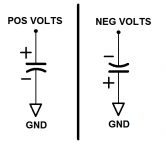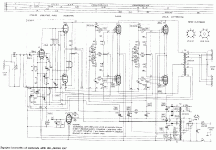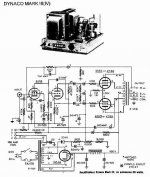Isn't that a problem that the choke is rated 2H at 300 mA? just because I am still searching for a hammond choke rated at the same specs, and stumbled upon that the transformer is 600 mA.
Only approx. 1/2 of the rated RMS current of a winding is available as DC, when cap. I/P filtration is employed. The ratings of the magnetics are correct.
So i can order that hammond choke too? 🙂
I see on the schematic an Edcor XC87-2H-300. That's fine, that's 2H 300mA. But I can't find which Hammond choke you're asking about. Do you have a model number for that?
--
I see on the schematic an Edcor XC87-2H-300. That's fine, that's 2H 300mA. But I can't find which Hammond choke you're asking about. Do you have a model number for that?
--
this one
Choke
Although it is rated 200 mA :/
If you're building a stereo amp, then you definitely need the 300mA rated choke. The output tubes draw about 45mA each, and you'll have four of them going, so that's 180mA right there. The driver tubes will draw about 7mA each, and there are two of those, so that's another 14mA or so. 200mA would be the barest minimum. The inductance of the choke will fall once its core is saturated, so it's a waste of money to get one with insufficient current capacity.
Use a 250mA or 300mA rated choke.
What's wrong with this one?
--
Obisix, are you ordering output transformers from Edcor? Is so, can't you get the Edcor 2H 300mA choke at the same time?
Reading back through the thread, I see that the operating point for each 7591 is projected to be about 400V from plate to cathode, and 40mA idle current, so there will be 160mA standing current from the four output tubes. Also, the 12AT7 tubes are predicted to draw 3mA each, so 12mA since there are four of them. 160mA plus 12mA is 172mA current from the power transformer at idle.
While the 200mA rated Hammond choke looks like enough, bear in mind that during program peaks the output tubes can draw quite a bit more than 40mA each. If they all drew 50mA at once, the 200mA rating of the choke would be reached, and the inductance of the choke could collapse to far less than 1H. Basically, that would mean the nice filtering you were getting from the choke could go away, right when the musical peak has driven the amp to full power. Power supply ripple would shoot up during the peak, probably making the peak and any overload sound nastier than it should.
I'm familiar with this effect from guitar amps, which are often intentionally run in overload, with their power supplies being run at their limits. If power supply ripple (hum) suddenly shoots up, a sound like a low frequency second note 'humming along' with the desired signal may take place. That's caused by the audio signal (the notes from the guitar) modulating with the mains hum from the transformer. I've oversimplified, but I think it gets the idea across. That's something you don't ever want to hear from a hi-fi amplifier.
The lesson I took from the above is that a heavy duty, intentionally over-specified power supply is a very good thing. Eli mentioned it earlier too.
Perhaps your transformer winding friend can wind you a choke. A power supply choke is much simpler than an audio transformer. I think all you need to know is that it's a power supply choke designed to filter 50Hz AC, it should be 2H (or more, if possible 🙂 ), and it needs to pass 300mA without saturation of the core. The DC resistance of the winding should be as low as possible.
Perhaps Eli or someone else with more knowledge and experience than I have can add more detailed specifications to ask for.
--
Reading back through the thread, I see that the operating point for each 7591 is projected to be about 400V from plate to cathode, and 40mA idle current, so there will be 160mA standing current from the four output tubes. Also, the 12AT7 tubes are predicted to draw 3mA each, so 12mA since there are four of them. 160mA plus 12mA is 172mA current from the power transformer at idle.
While the 200mA rated Hammond choke looks like enough, bear in mind that during program peaks the output tubes can draw quite a bit more than 40mA each. If they all drew 50mA at once, the 200mA rating of the choke would be reached, and the inductance of the choke could collapse to far less than 1H. Basically, that would mean the nice filtering you were getting from the choke could go away, right when the musical peak has driven the amp to full power. Power supply ripple would shoot up during the peak, probably making the peak and any overload sound nastier than it should.
I'm familiar with this effect from guitar amps, which are often intentionally run in overload, with their power supplies being run at their limits. If power supply ripple (hum) suddenly shoots up, a sound like a low frequency second note 'humming along' with the desired signal may take place. That's caused by the audio signal (the notes from the guitar) modulating with the mains hum from the transformer. I've oversimplified, but I think it gets the idea across. That's something you don't ever want to hear from a hi-fi amplifier.
The lesson I took from the above is that a heavy duty, intentionally over-specified power supply is a very good thing. Eli mentioned it earlier too.
Perhaps your transformer winding friend can wind you a choke. A power supply choke is much simpler than an audio transformer. I think all you need to know is that it's a power supply choke designed to filter 50Hz AC, it should be 2H (or more, if possible 🙂 ), and it needs to pass 300mA without saturation of the core. The DC resistance of the winding should be as low as possible.
Perhaps Eli or someone else with more knowledge and experience than I have can add more detailed specifications to ask for.
--
Thanks Rongon for the detailed informations, it was really helpful for me! 🙂
I'm not ordering O/P irons from Edcor, but from Hammond, as my financial state is only giving me this much of freedom, so ordering from America is a no-go.
But Hammond transformers are widely used in Europe, thus it is reseller at a really reasonable price.
And also, you have found me a better choke than I did, so your searching skills are beyond mine! 😀 I will just order that one
I'm not ordering O/P irons from Edcor, but from Hammond, as my financial state is only giving me this much of freedom, so ordering from America is a no-go.
But Hammond transformers are widely used in Europe, thus it is reseller at a really reasonable price.
And also, you have found me a better choke than I did, so your searching skills are beyond mine! 😀 I will just order that one
Last edited:
Eli, or Rongon!
Are the capacitors on the B- and C- are in good orientation? Seems so weird for me, if anyone can explain why I need to connect it the other way that'd be great!
Are the capacitors on the B- and C- are in good orientation? Seems so weird for me, if anyone can explain why I need to connect it the other way that'd be great!
Eli, or Rongon!
Are the capacitors on the B- and C- are in good orientation? Seems so weird for me, if anyone can explain why I need to connect it the other way that'd be great!
The positive side of electrolytic caps. get grounded, when the rail is negative.
We'd better make sure this is clear to you, or else big, messy bangs can happen. I've attached a picture. I hope it helps.
PS - I think it would be a good idea if you bought a copy of Morgan Jones' "Valve Amplifiers" and really studied it. It doesn't matter if you get the 3rd edition for cheap, or the current 4th edition. They have different stuff, but the basics are covered in a way that's fun to read, with just enough detail to make things interesting. I think Morgan's a really good writer, and makes this stuff as easy to read as possible.
To buy the 4th edition:
http://www.amazon.com/Valve-Amplifiers-Fourth-Edition-Morgan/dp/0080966403
--
PS - I think it would be a good idea if you bought a copy of Morgan Jones' "Valve Amplifiers" and really studied it. It doesn't matter if you get the 3rd edition for cheap, or the current 4th edition. They have different stuff, but the basics are covered in a way that's fun to read, with just enough detail to make things interesting. I think Morgan's a really good writer, and makes this stuff as easy to read as possible.
To buy the 4th edition:
http://www.amazon.com/Valve-Amplifiers-Fourth-Edition-Morgan/dp/0080966403
--
Attachments
Eli, would the ferrite bead slide onto the primary or would the wire loop around the bead? Do you have a part number for the beads? The Antek transformers I've worked with pick up substantial amounts of "garbage".Put ferrite beads on the "free" primary wires. Toroids are wide bandwidth and you want to suppress garbage riding on the AC mains.
You want good sized beads with a large central hole. Definitely loop the wire around the bead. More turns = more inductance and greater trash suppression. Check the various parts houses, starting with Mouser, to find a nice item.
BTW, chamfered beads are in order, to avoid nicking wire/insulation.
BTW, chamfered beads are in order, to avoid nicking wire/insulation.
Thanks Eli. It's hard to find high voltage non-toroidal single secondary transformers. I pretty much gave up on bridge rectifiers because of the noisy toroids. I'll give the Anteks another try with beads.
Okay Guys, sorry for not posting for a loooong time, I just bought my new house and had to renovate it! 🙂
The amp is ready to be built, and I am ready to gather the components!
A friend of mine alerted me of some chokes he is trying to sell for cheap:
A HAMMOND 193L, which produces 5H @ 300mA for 10 000 HUF, which is 35 USD according to Google.
Or a HAMMOND 193K, which produces 2,6H @ 300mA for the same price.
Can I buy the 193L one? Is it "better" to have that one, rated higher inductance?
Thanks for the help:
Sebastian
The amp is ready to be built, and I am ready to gather the components!
A friend of mine alerted me of some chokes he is trying to sell for cheap:
A HAMMOND 193L, which produces 5H @ 300mA for 10 000 HUF, which is 35 USD according to Google.
Or a HAMMOND 193K, which produces 2,6H @ 300mA for the same price.
Can I buy the 193L one? Is it "better" to have that one, rated higher inductance?
Thanks for the help:
Sebastian
Okay Guys, sorry for not posting for a loooong time, I just bought my new house and had to renovate it! 🙂
The amp is ready to be built, and I am ready to gather the components!
A friend of mine alerted me of some chokes he is trying to sell for cheap:
A HAMMOND 193L, which produces 5H @ 300mA for 10 000 HUF, which is 35 USD according to Google.
Or a HAMMOND 193K, which produces 2,6H @ 300mA for the same price.
Can I buy the 193L one? Is it "better" to have that one, rated higher inductance?
Thanks for the help:
Sebastian
All things being equal, the larger inductance power supply choke will allow you to get good ripple suppression (hum reduction) with lower value capacitors, which will reduce the current inrush surge at turn-on, so everything should last longer. Or, you can use the same value capacitors and enjoy a quieter power supply rail using the larger value choke. I don't think there is a downside to using the larger value choke, as long as it will physically fit on your chassis.
If you can use it, I vote for the larger value choke.
--
If it does not even fit, I can still mount it on top of the chassis! 🙂 Okay, I'm going to buy it!
Anything going on in this thread.
It seems like it abrubtly stopped. I was realy interested in Eli's design of the higher power El Cheapo. Did it continue somewhere else?
If it does not even fit, I can still mount it on top of the chassis! 🙂 Okay, I'm going to buy it!
It seems like it abrubtly stopped. I was realy interested in Eli's design of the higher power El Cheapo. Did it continue somewhere else?
- Home
- Amplifiers
- Tubes / Valves
- Choosing a tube amplifier to build, HELP needed



